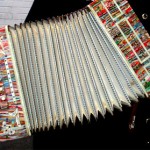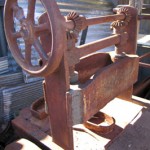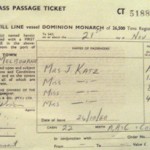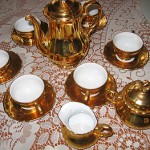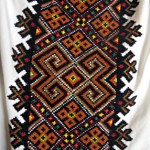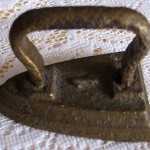(nee Roperti)
Italian
Clonflenti, Catanzaro, Italy
Messina, Sicily, Italy on 27 January 1954
Sydney on 28 February 1954
Warriewood, Sydney with my father and his cousins
Machinist at Top Dog (Bonds) clothing factory in Dee Why, Sydney
Machinist at Marco in Balglowah, Sydney
I was born into a family of farmers on 29 May 1934 in Conflenti, a small town in Catanzaro, Italy. We didn’t own the land ourselves but planted and tended various crops including wheat, corn, potatoes, tomatoes and cucumbers as well as raising goats, pigs and chicken for our local landlords. At the end of each season they divided up the profit from the crops on a 50:50 basis. For most families trying to survive in post-war Italy, times were very hard and it was almost impossible to make enough to live on. So it became quite common for the men folk of the village to leave home and look for work elsewhere. Sadly sometimes, far, far away.
My father, Michele Roperti, was no exception. He had heard about the possibility of work in Australia from his cousins who had migrated there in about 1949. They convinced my father that he could make a much better living in Australia and so he decided to migrate too. Unfortunately, he was forced to leave his wife and children at home while he tried to secure a better future for his family. He arrived in Sydney in 1952 and moved in with his cousins sharing a house in Brookvale. He found work at the Warriewood glasshouses and later moved to live in that area.
Being the eldest of the four children, I was the next one to come to Australia. I was nineteen at the time and I came alone, leaving Messina on board the Oceania on 27 January 1954 and arriving in Sydney one month later. This was an extremely difficult time for me leaving behind my mother, brother and sisters. I was scared too, it was all so strange to me as I had never been away from home before.
My father, his cousins, relative and friends met me in Sydney. I still felt very confused and sad; I was still thinking constantly about my family back in Italy. But it wasn’t long before I had my first job and that helped me because at least I was busy and helping my family at the same time. I was employed as a machinist, even though I had not had any previous experience, at Top Dog, a clothing factory in Dee Why. This factory would later become known as Bonds. It was a large factory that employed lots of migrants like me who manufactured clothing such as shirts and pyjamas. I stayed there for two years and then moved on to another factory in Balgowlah called Marco that made shirts. My job there was once again as a machinist but as least this time I had had some experience behind me.
In April 1956, my mother Angela, brother and sisters arrived and we all moved into a rented house in Brookvale, Sydney. I was so much happier now that I was reunited with my family. It had been very hard for me to be away from them for those two long years. The only person missing from my life now was my fiancé, Battista Benvenuto.
Battista and I had been neighbours in Conflenti, growing up together. We were engaged to be married in Italy before I left to come to Australia. When Battista applied to migrate, it was not an easy matter, because he was not a blood relative of ours. He was made to wait over two years before his application was accepted. I was visited by the migration authorities here in Sydney to verify his position and helped organise some of the official papers for him. We were married not long after his arrival in February 1957 and we bought our first house at Williams Street, Brookvale. We had three wonderful children, Felia, Elvina and Nicolino.
My husband was at Brickworks in Frenchs Forest where he worked manually for seven years before more finding more factory work in Dee Why at a place that made rope products.
Back in Conflenti, my husband worked on the land but in his spare time he learned from the local barber how to cut hair and shave beards. So in his spare time he used to trim the hair of all his family and friends. When he decided to migrate to Australia, he made sure that he packed his barber kit. He did the same thing in Australia. He became very good at it. It was obviously something he enjoyed doing because he spent almost all his spare time catching up with everyone and giving them a trim.
My husband also packed his organetto (piano accordion). He learned to play it when he was a young shepherd in the hills of Conflenti. He and the other shepherds used to have to go into the hills at night to look after the livestock. During the day, while the animals grazed happily on the rich pasture they had nothing much to do. To fill the hours they taught themselves to play the accordion. Battista became a very talented musician and in Australia was often called upon to play at feste (parties) and family celebrations.
For the last 25 years our family has lived happily in the same house. My husband sadly died just over a year ago and so his barber kit and organetto have become very important not only to me but to the rest of my family. The barber kit has been placed in a wooden box with a glass cover so that we could proudly put it on display. These precious belongings will definitely be handed down to our grandchildren as loving mementos of a wonderful husband, father and grandfather.





